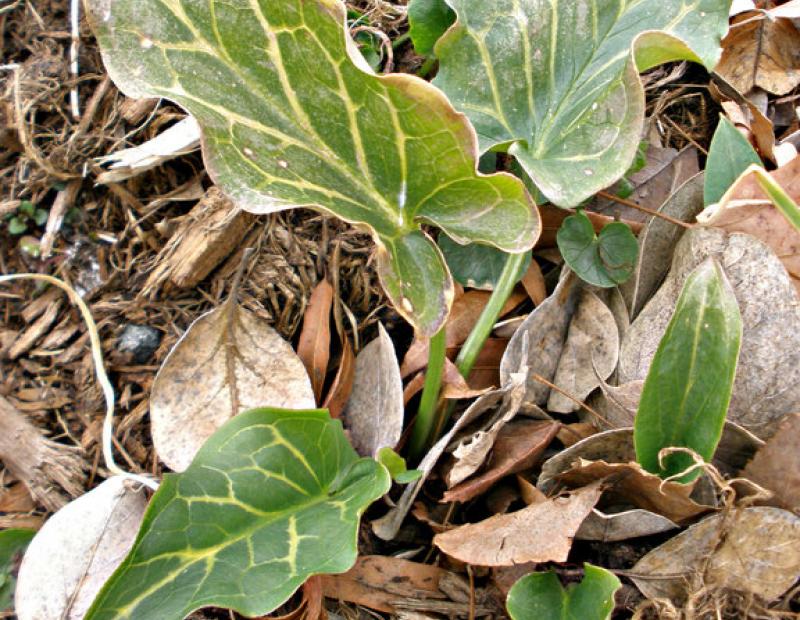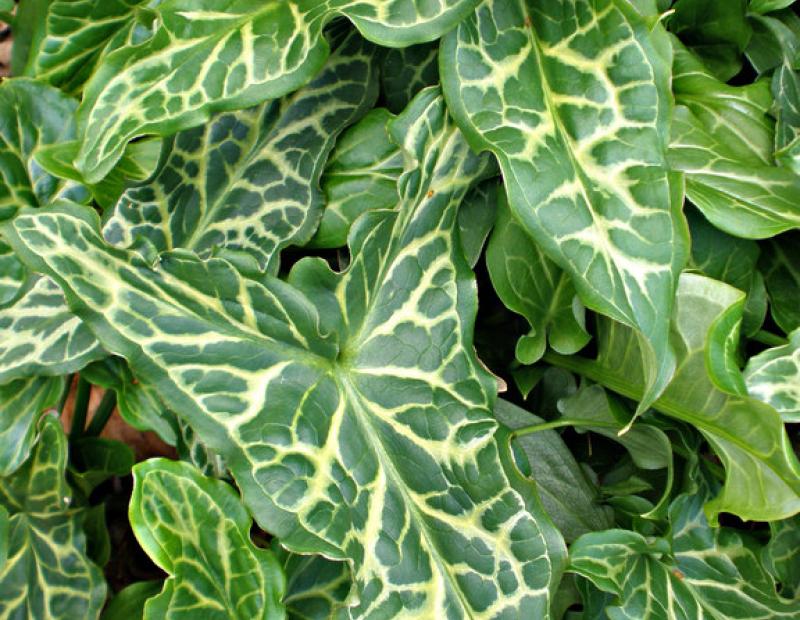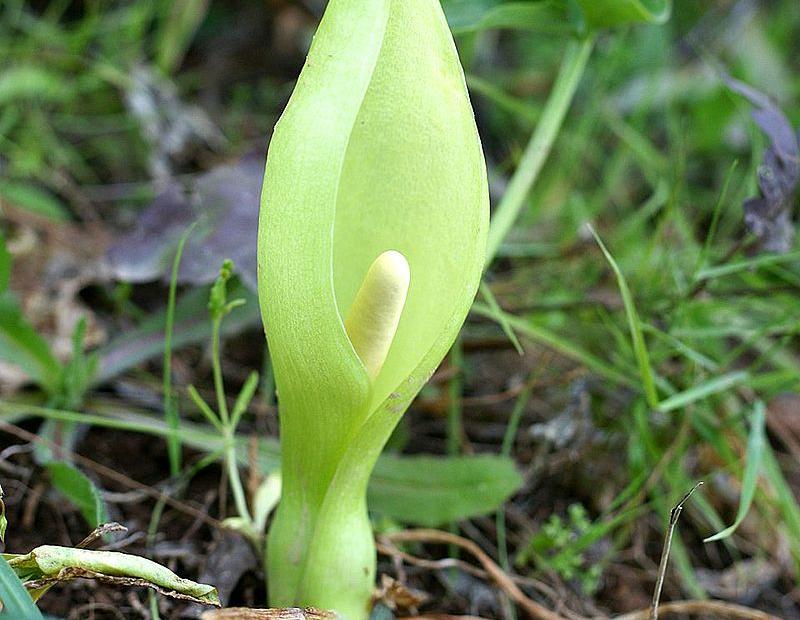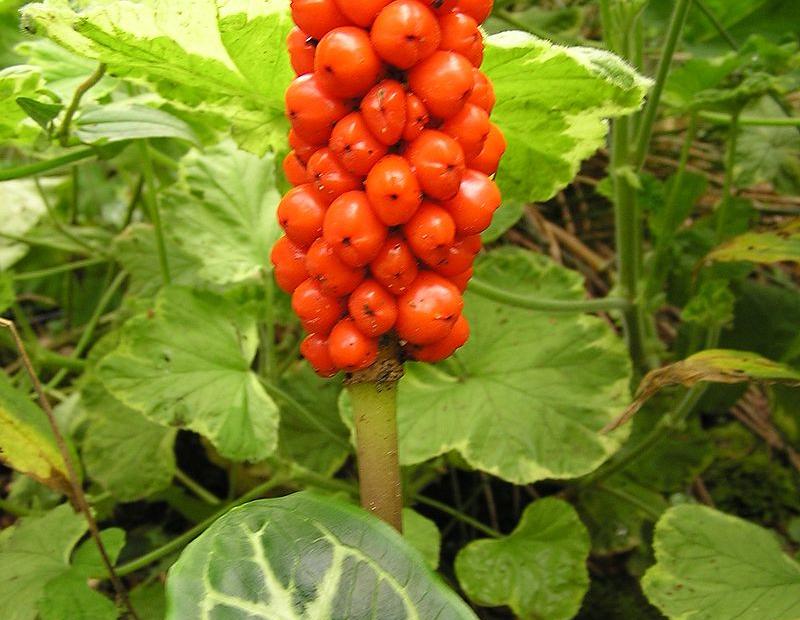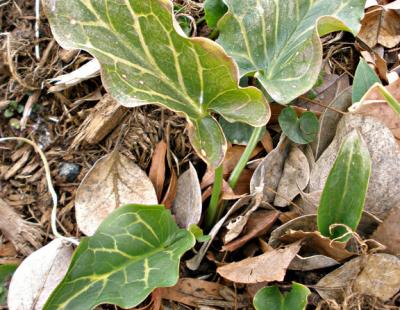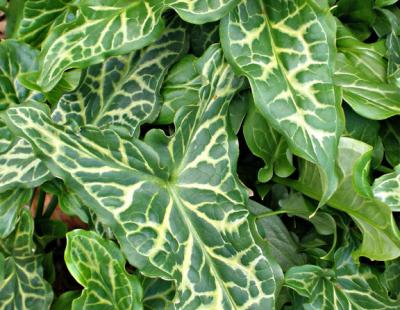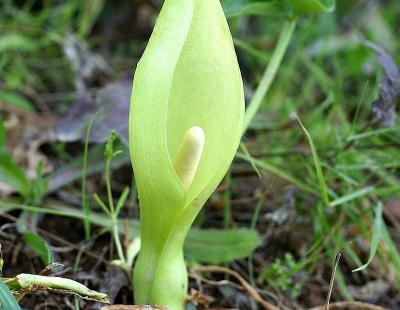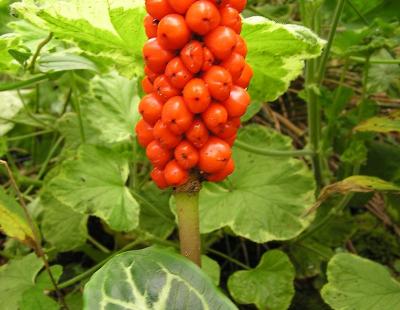Vertical Tabs
Italian arum is a popular specimen for the garden due to its striking, evergreen foliage, Italian arum is native to the Mediterranean region. The species has large, often variegated leaves and an unusual flower, similar in appearance to its relatives’ flowers — skunk cabbage, calla lily— which consists of a spadix subtended by a creamy-green spathe. The species is most conspicuous in the summer and fall when bright orange berries ripen on a tall stem. (2, 3)
Leaves
Leaves are glossy, grayish-green with pale midribs (and often variegated), arrow shaped, and up to a foot long. Leaves are technically ‘stemless’ and arise on long petioles from the plant’s base. (4)
Flowers
Flowers are classic Arum family flowers and resemble Jack in the pulpit (Arisaema triphyllum), Skunk cabbage and other native Araceaous plants. An erect spike of creamy, tiny flowers is arranged at the end of a long stem and partially enclosed by a leaf-like, hood structure known as a spathe, which is creamy to greenish in color. Flowers are produced in spring. (4)
Fruit/Seed
Fruits are highly conspicuous orange berries arranged on a spike. They ripen towards the end of summer and may persist on the plant, if not dispersed by birds, for several months. Berries are highly toxic to mammals. (4)
As a relatively new invader in the Northeast, little is known about the ecological impacts of Italian arum in this region. Capable of reproducing both via seed and underground bulblets, this species has been identified as invasive in the Northwest, where it readily spreads into natural areas and is extremely difficult to manage. Italian arum’s tendency to form dense aggregations can cause alterations in the diversity and heterogeneity of herbaceous layer in the communities it invades. This species is toxic to humans and mammals. (1)
Biological Control
There is no biological control agent available at this time.
Manual or Mechanical Control
Pulling / Digging Up: Pulling is effective only on very small populations as all bulblets and below ground plant material must be removed to have total control. This is a time-consuming process that must be undertaken fastidiously. (2)
Mowing: Not advisable. Fruit can be cut and bagged prior to ripening to help slow the spread. (8)
Girdling: Not applicable
Prescribed Fire: No information available
Prescribed Grazing: Not advisable. This plant is toxic to mammals. (2)
Soil Tilling: Not advisable. Tilling can encourage the dispersal of Italian arum’s bulbets and lead to the creation of more plants. (6)
Mulching: Landscape fabric has been utilized in combination with other control methods to achieve some measure of success. (6)
Solarization: No information available
Hot Foam Spray: No information available
Chemical Control
The pesticide application rates and usage herein are recommendations based on research and interviews with land managers. When considering the use of pesticides, it is your responsibility to fully understand the laws, regulations and best practices required to apply pesticides in a responsible manner. At times, the pest you seek to treat may not be on a pesticide label, requiring a 2ee exemption from NYSDEC. Always thoroughly read the label of any pesticide and consult the NYSDEC or a licensed pesticide applicator with questions.
Foliar Spray: A 3% foliar spray of glyphosate and metasulfuron during growing season is effective at killing above ground foliage but will require repeat treatments to target Italian arum’s underground tubers and bulblets. Always read and follow all directions on the herbicide label and take care when applying in wet areas. (7)
Cut Stump: Not applicable
Basal Bark: Not applicable
Stem Injection: Not applicable
Pre-Emergent Spray: No information available
As with any other invasive infestation complex, Italian arum is best managed via a combination of mechanical and chemical means. Very small populations may be effectively controlled by careful hand pulling. Larger populations may warrant repeat foliar spray application. All managed infestations should be monitored for several years to manage any germination of new seedlings or re-sprouting of remaining bulblets that occurs. New seedlings can be hand pulled or sprayed.
Post treatment monitoring
Controlled populations should be revisited for several years to ensure no germination of new seedlings or re-sprouting has occurred.
Disposal Methods
Pulled Italian arum fruit, tubers, bulbets and any soil surrounding plant parts must be bagged and disposed of in a landfill. Leaves can be composted. (7)
REFERENCES
- https://www.invasiveplantatlas.org/subject.html?sub=13931
- https://www.portlandoregon.gov/bes/article/433196
- https://wmswcd.org/species/italian-arum/
- http://www.missouribotanicalgarden.org/PlantFinder/PlantFinderDetails.as...
- https://gobotany.newenglandwild.org/species/arisaema/triphyllum/
- http://www.co.cowlitz.wa.us/DocumentCenter/View/13974
- https://www.whatcomcounty.us/DocumentCenter/View/27070/Italian-Arum-Mana...
- https://s3.wp.wsu.edu/uploads/sites/2054/2014/04/Italian-Arum-brochure.pdf
- https://www.aroid.org/gallery/gibernau/aroideana/0270009.pdf

